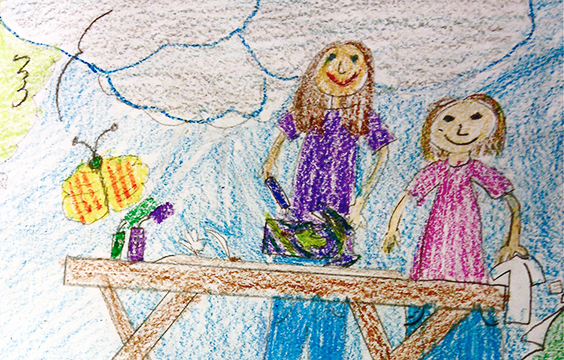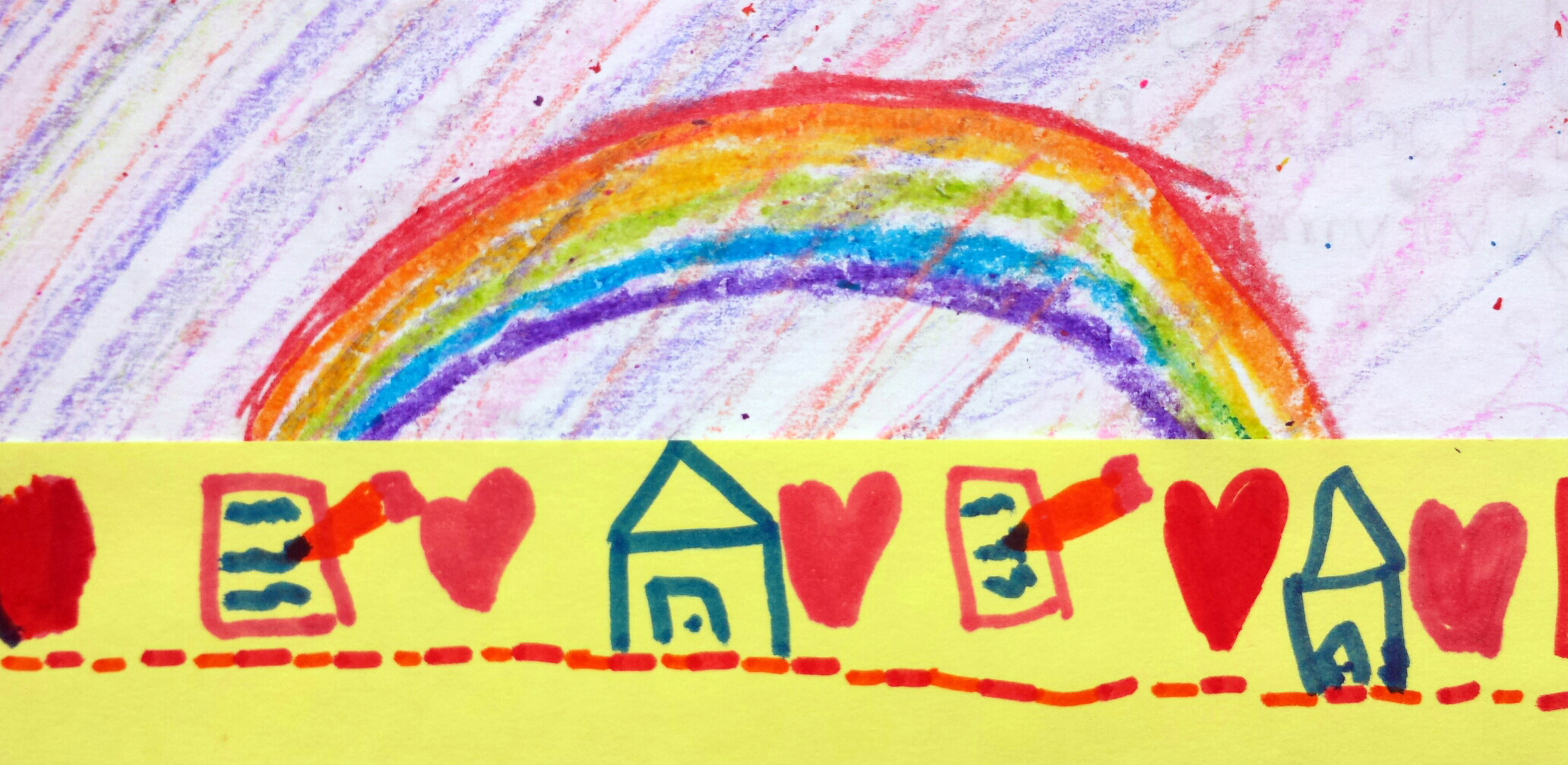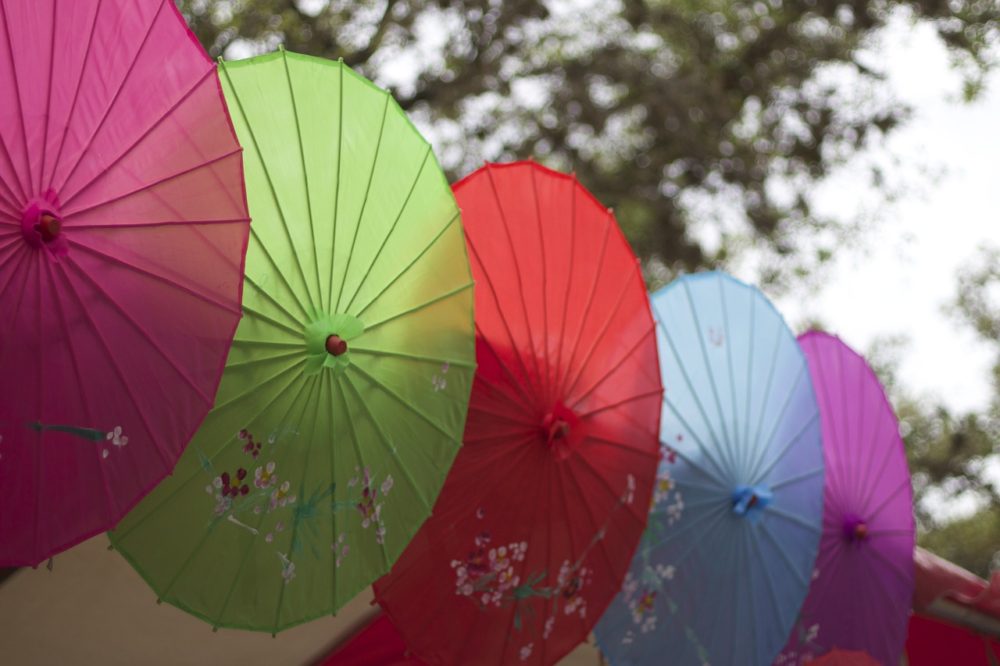Third-grade teacher Kevin Baxter’s students turned their stories into books and their collective work into a classroom quilt.
Words are like harpoons. Once they go in they are very hard to pull out.
—Fred Hoyle
Asheville, North Carolina
As Hannah sits with her legs folded beneath her, she hunches down over her drawing of a day in the woods with her mom, carefully weaving a long piece of gold yarn in and out of holes she had punched earlier. As she struggles to create the in-and-out pattern necessary for achieving the image she wants, I ask her about her illustration.
“Hannah, what do you remember about that day? Where were these woods?”
“Down by Sliding Rock. In the national forest.”
“Why did you choose that day for your drawing?”
“I like walking in the woods with my mom. We usually find lots of interesting objects.”
Our third-grade class is in its element, in the midst of the flow, from ideas to discussion to writing to art. The heart of the creative process. These children have much to say about their lives, so they must have a venue, a project, something to allow them to express themselves. This quilt project seems to fit the bill.
Two months before, I read aloud from what I decided was the perfect book for my class, these children who are growing up in the southern Appalachian Mountains: Cynthia Rylant’s When I Was Young in the Mountains. In the illustrated book, Rylant creates images—snapshots—of what it was like to be a young girl up in the northern part of these mountains. Readers follow her to visit a local country store where the long-married owners’ hair is as white as the milk they sell, then witness brothers and sisters drape a huge snake around shoulders for a family photo, before taking a plunge in the local swimming hole.
When the story is finished, hands raise up.
“We have a swimming hole near our house!”
“My mom hates snakes. She would never let us do that.”
“My memaw has white hair just like that lady in the store.”
The very next day, the children find a piece of drawing paper on their desks.
“You are going to create a book. The book will hold all of your stories about what it’s like to grow up in these mountains. You may either illustrate or write first. However, you must do both. Don’t tell me,” I say. “Show me.” After a few moments of explanation, the children begin their questions.
“Can I write about having lunch with my stepdad?”
“Of course!”
“I want to write about playing ‘Call of Duty’!”
“Nope. That’s not about you. That’s about a game.”
“Fishing?”
“Yes. Absolutely yes.”
“I saw this great movie…”
“Stop. No. And you know why.”
“My Gram is sick.”
“Yes, please write all about your Gram.”
Their stories deepen as their drawings become detailed (pencil or colored pencil only please, no crayons or markers). Students cluster in twos and threes to edit and revise the two stories they create each week. During this process, the stories are embellished. Their writing details walks in the woods, picnics at the beach, weird aunts and uncles paying a visit, catching the big one, working with Grandpa’s tools, cooking with my baby brother, Mom struggling up Mt. Pisgah. Before they know it, the pages are complete and the process of creating the books begins.
*
Hannah
When I was young my mom and I would sit on the porch step and talk at night as the crickets chirped. We would talk about the day, my life and her life. It was very relaxing to sit with my mom and laugh and cry. I think that the mountains hold my tears and my laughter.
*
My wife Jodi, a quilter as well as a teacher, has graciously accumulated an array of floral and leaf print cloth swaths for my students to select and use as book covers. She has had her classes do similar projects and has a good eye for just the right designs.
I implore my students to consider their cover choices carefully, to think about the voice of their particular book. Color may be a consideration as some have many pictures showing the Carolina sky as the main feature. Sensing this might happen, my wife has selected a lovely deep blue cloth with billowing white clouds as one of the choices for the students. Others are attracted to a wonderful autumn brown with gold leaf print. A few like the fields of daisies, while the majority selects the main themed print, featuring blue mountains rising majestically against a backdrop of purple sky.
*
Kaleb
When I was young I would watch the fire in the fireplace. My eyes were paralyzed by the flames like a bug trapped in a spider’s web. The crackle of the flames sounded like red, white and blue fireworks blowing up. But . . . fires don’t last forever.
*
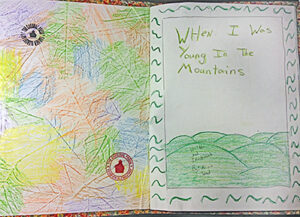
After the book covers are selected, we spend the next few science classes studying and discussing indigenous North Carolina leaf patterns. Then it’s outside to find the leaves so we can make leaf rubbings for the inside of our book jackets.
“Jamie, I see you have chosen all of the same type of leaf. You don’t want to vary your design?”
“Nope. I like the way the elm leaves have jagged edges. It’ll look cool!”
“That it will.”
*
Theo
Me and Zachary Parks would sometimes camp out in the grassy green grasses of my front yard. We would always talk about what we were going to do when the bright sun rose. We weren’t scared because you could hear my dog barking and the birds chirping. Also because we had each other.
*
The students go back in to trade, cut, symmetrically fold, and arrange their leaves on their pages. Hidden math, I am thinking, spatial relationships. Then they must rub, rub, and rub more to create the desired, multi-layered effect. Beautiful! Carolyn is carefully gluing down her front and back page onto the inside front and back of her cardboard book cover.
The next day, volunteer parents sit with small groups of children to help them stretch and fit the cloth covers they have chosen and glue them down over the edges of the leaf rubbings. After making copies of the students’ favorite illustrations from their books (to be used for the next part of the project) I bring the inside pages and covers home, where Jodi will stitch them together.
*
Lena
My mom took me to the movies. We were watching it when someone behind me started throwing popcorn at me. I stood up to see who sat behind me. It was a little boy. My mom said he liked me. “Do you want to know how I know that? He told me he did!” Oh no!
*
A few days later: “Who wants to see their finished books? Here’s the deal, whoever gets their work finished by lunchtime will have first look-sees!” Such a productive morning!
Next comes the selection of their favorite illustrations to be featured on the class quilt. The students enjoy the process of selecting these illustrations, a few chosen for subject matter, while others choose the one they believe is their best work. It doesn’t matter to me. I just enjoy watching them go through the all-important selection process. Making a thoughtful decision, judging what one deems best to be put on display is an important process for children. It makes them think about value.
*
Once the selections have been made, they must make yet another decision. How are these twenty-two pages going to be arranged on the eight-by-three foot paper quilt? Will the determining factor be color, type of scene, or selfishly, I want mine on top? It’s a dilemma for sure, but a necessary step in this cooperative exercise. Twenty-one kids walking around a huge rectangle, hashing out a problem. There is so much for a teacher to observe: Kristin and Theo are being bossy. Justin couldn’t give a rip. Mary Kate is offering some excellent ideas, but no one is listening because everyone is talking at once.
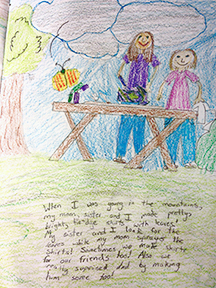
Time to interject:
“You know, boys and girls, this quilt is going up in the main hall alongside the others from my last three classes. Everyone who walks down that hall will be seeing this quilt…and comparing it to the other three. You have created some excellent pictures. They really tell a story about who you are. Think about this quilt as just that: your story in pictures. Now, how do you want people to read it?”
They begin to think. There is not so much chatter now.
Sam offers, “Maybe we could put all of the boys’ stories on one side with the girls’ on the other?” Not a bad start.
“I know!” says Rebecca, “Let’s do it by category—animals, beach, woods, things like that!”
Better!
Then Logan, who hasn’t said a word all day, finally speaks.
“What if we arranged all of the pictures to tell a story… if we can?”
Jackpot! The students get the night to think it over as part of their homework. The next day they use story time to rearrange the pictures to tell their story, and it’s a good-un!
Brooke rode her horse to Rebecca’s to have breakfast with her grandpa who took them both to the zoo to see Ryan’s elephants and…so on…
Did it all make any sense in the end? Probably not, but the pictures did fit well together with a few last-minute revisions.
*
Tessa
When I was young my father, brother and I would go on summer drives. We went in Old Blue. She has no top. Old Blue is a Land Rover, so we can go anywhere we want. As my dad started her up after dinner, we all piled in the front and that hum feeling came upon us. As we drove the orangish, purplish sun was drifting behind the mountains. The birds chirping, the wind blowing in my face. I thought we would just ride away into the sunset.
*
As Hannah finishes her stitching, she stands up, backing up a few steps to admire the quilt.
“It’s a beauty, Mr. B!”
The rest of the class moves over to the quilt from their desks to check it out. Hannah, the last to finish her stitching, has beautifully blended her gold yarn in with the browns, yellows, and reds the class has chosen to create an autumn effect that is perfect for our Young in the Mountains story quilt.
The children circle around the quilt, gently sliding their forty-four hands beneath it to carry it to the main hallway. They hang it proudly next to the ones from my previous three classes, the four quilts combining to make a stunning display for passersby to enjoy. For days on end we see children and adults alike stopping to admire and talk about the pictures on the quilts, adding their own versions. Now the quilt is part of the school community, functioning as a story starter.
“I’ve been to that place!”
“I ride horses too!”
Two weeks later, Taylor stands proudly at the podium during our Author’s Tea, her completed book held up so that the assembled parents can ooh and aah over its gorgeous, cloud cover. She begins to read:
Taylor
I went fishing with my dad. Then when my dad passed away his best friend took me fishing. His name is Wittner. I caught a bigger fish than him. Wittner is the best. He calls me Tiny Taylor. I caught one fish and it took me five minutes to catch it. It was humongous. I love fishing.
Twenty-two readings full of laughter, heartbreak, adventure, mystery, birth, life, and death follow. At the end, parents are hugging their children, wiping tears, kissing.
The books are cradled in grandparents’ arms, treasures to be saved for great-grandchildren, who will one day be young in the mountains.
*
Hannah
On weekends my mom, dad, my brother, and I watched the sunset together. Seeing all the blues, pinks, purples, and reds in the sky, it was just relaxing to be with your family, watching the sunset, chasing fireflies, and barbecuing supper. It is surely nice to be watching the flickering of the fire and fireflies dancing around the moon. It is peaceful to be in the mountains, so very comfortable to be in the mountains. When I was young I was sitting on my screen porch listening to my mom telling a story about when she was young.
Listening to the words with my ears, knowing that I was safe and protected, I softly fell asleep.
Kevin Baxter holds a masters degree in early childhood education, a bachelors degree in elementary education, and is a certified teacher of the gifted. He has taught pre-school though fifth grade and has also taught masters-level courses on reading disabilities at the University of San Diego. He spent 12 years teaching in Saudi Arabia and conducted teaching workshops in various countries around the world. He currently resides in Asheville, North Carolina, and was a Buncombe County Schools Teacher of the Year.

